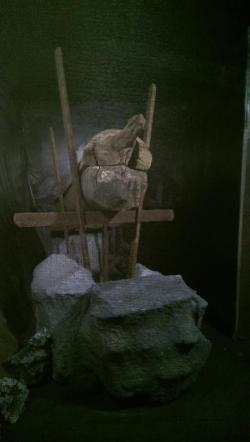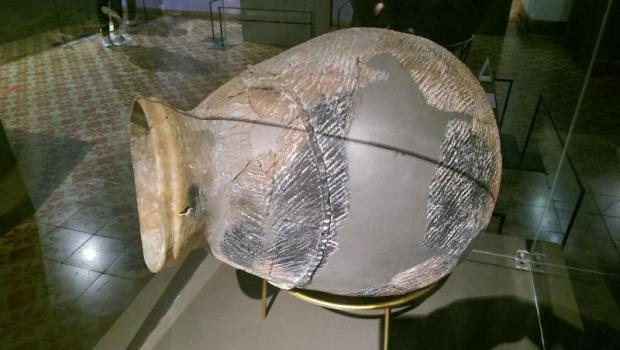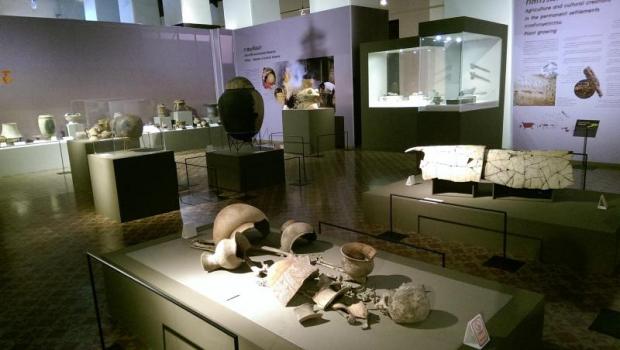Visiting museums in Thailand is no longer dull since several museums have been renovated and well-presented. Since its big improvement late last year, the 128-year-old National Museum Bangkok regularly comes up with rotating exhibitions. The latest is the ongoing "Early Man Of Our Land" exhibition, which will be held until Aug 21 at Issaravinitchai Throne Hall.
Organised by the Fine Arts Department and the committee for Thai Heritage Conservation Day, this special exhibition provides an account of the prehistoric dwellers and related social-cultural development in Thailand through the display of information and 329 artefacts.
Stepping into the hall, visitors will be introduced to the background of the term "prehistoric" and prehistoric archaeology in Thailand before seeing the highlight -- the evidence of the earliest human in Thailand. The masterpiece is a forehead bone of a Homo erectus unearthed from Hat Pudai Village, Na Seng in Ko Kha district, Lampang, in 1999. Borrowed from Siriraj Hospital's Sood Sangvichien Prehistoric Museum and Laboratory, this skull fragment dates back to about 500,000 years ago and was nicknamed as the skull of "Lampang Man". Also at this site, some flaked stone tools and animal bones were found.
The evolution of human beings began from Australopithecus 5 million years ago to Homo habilis 2.5 million years ago, Homo erectus 1.8 million years ago and Homo sapiens 300,000 years ago. Homo erectus had a larger braincase than their ancestors. They could stand upright, move with two feet, make and control fire and manufacture edged tools from natural stone. In later times, the biologically modern human, Homo sapiens, which means "the wise man", evolved from the descendants of Homo erectus.
The early Homo sapiens skeletons found in Thailand include a skeleton of a woman dating to about 25,000 years ago unearthed at Moh Khieo Cave in Muang district, Krabi province, and two skeletons of women dating to 13,640 years ago and 12,100 years ago excavated at Tham Lod rock shelter in Pang Ma Pa district, Mae Hong Son province.

A dugout wooden coffin from Ong Ba Cave in Kanchanaburi province. Pichaya Svasti
Also on view at this exhibition are animal bones, fangs, stone tools and seeds from various archaeological sites in Thailand, such as Tham Lod rock shelter.
Past scholars classified prehistoric humans into three major ages according to the raw materials used in tool manufacturing -- the Stone Age (500,000-4,000 years ago), the Bronze Age (4,000-2,500 years ago) and the Iron Age (2,500-1,500 years ago). Flaked stone tools were usually found in early prehistoric sites. The oldest stone stools so far found in Thailand date to sometime between 600,000-800,000 years ago. They were discovered at Ban Mae Tha in Lampang province.
The next section is about cave art -- painting and engraving on rock surfaces of caves -- which can be found all across Thailand, especially in the Northeast with more than 100 sites in nine provinces.
Another highlight is a dugout wooden coffin for the burial ritual of cave people found at Ong Ba Cave in Kanchanaburi province dating to 2,500-4,000 years ago. Prehistoric people used caves as shelters and also cemeteries. Several of these caves in Mae Hong Son and Kanchanaburi house dugout wooden coffins, which were made of whole large trees, containing human skeletons. Each coffin was 2-3m long. Both ends of each coffin were carved into the shapes of human or animal heads. This is a style of burial practice of prehistoric human in Thailand and also in Myanmar, Malaysia, the Philippines and China.
The next room displays information and artefacts about the earliest agricultural communities in the present-day Thailand about 4,000 years ago in the Neolithic Period (New Stone Age). It was where people grew rice, raised water buffaloes, pigs, chickens and dogs. They still practised fishing and wild animal hunting for daily consumption. Exchange of products between communities occurred. Ornaments made of marine shells seemed to be expensive commodities.
On view here are several rice grain-impressed objects from the Northeast as evidence of prehistoric agriculture. Also shown in this room is the evidence of first and second human burial rituals, weaving, pottery making, house building, animal raising and exchange of products in the prehistoric times.
Another section of the exhibition depicts mining and metal production in prehistoric times in the Bronze and Iron ages in Thailand.
The final part involves the scientific reconstruction of the face of a prehistoric woman from a skull from Mae Hong Son and disease identification in prehistoric human bones from Ban Chiang Site in Udon Thani.
Those diseases were cancer, osteoarthritis, tooth decay and periodontal disease and haematologic diseases, such as anaemia and thalassaemia. Interestingly, skulls of some human skeletons found at Ban Chiang contain round holes with smooth edge and cut marks, suggesting evidence of drilling to relieve the pain. This practice was also found in several Neolithic and Bronze Ages archaeological sites in various areas of the world.
"There have been traces of human settlements in Thailand for some 100,000 years. In the early historic age that began more than 1,500 years ago, or 'prehistoric period' as called by some academics, remains of archaeological evidence in various regions of Thailand prove that contemporary people who settled in this land had advanced in terms of culture," Fine Arts Department director-general Anandha Chuchoti noted.
The "Early Man Of Our Land" exhibition will be held from Wednesday to Sunday, 9am-4pm until Aug 21 at the Issaravinitchai Throne Hall, National Museum Bangkok. Call 02-224-1402 for more details.

The forehead bone of Homo erectus from Lampang is on view together with a model of a Homo erectus pekinensis skull found in Zhousoudian Cave, China. Pichaya Svasti

Bronze ornaments which were grave offerings from Noen U Lok Site in Nakhon Ratchasima dating to 1,800-1,900 years ago. Pichaya Svasti

Capsule-shape pottery for second burial rituals is from Roi Et province (1,500-2,500 years ago) and an infant burial jar is from Ban Chiang, Udon Thani province, (3,000-4,300 years ago). Pichaya Svasti

Capsule-shape pottery for second burial rituals is from Roi Et province (1,500-2,500 years ago) and an infant burial jar is from Ban Chiang, Udon Thani province, (3,000-4,300 years ago). Pichaya Svasti

